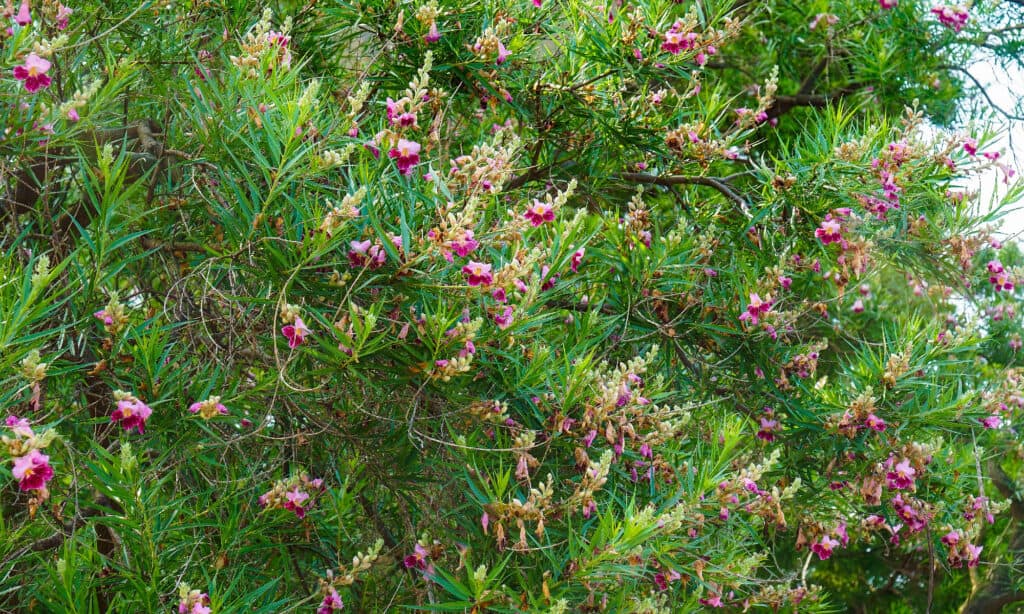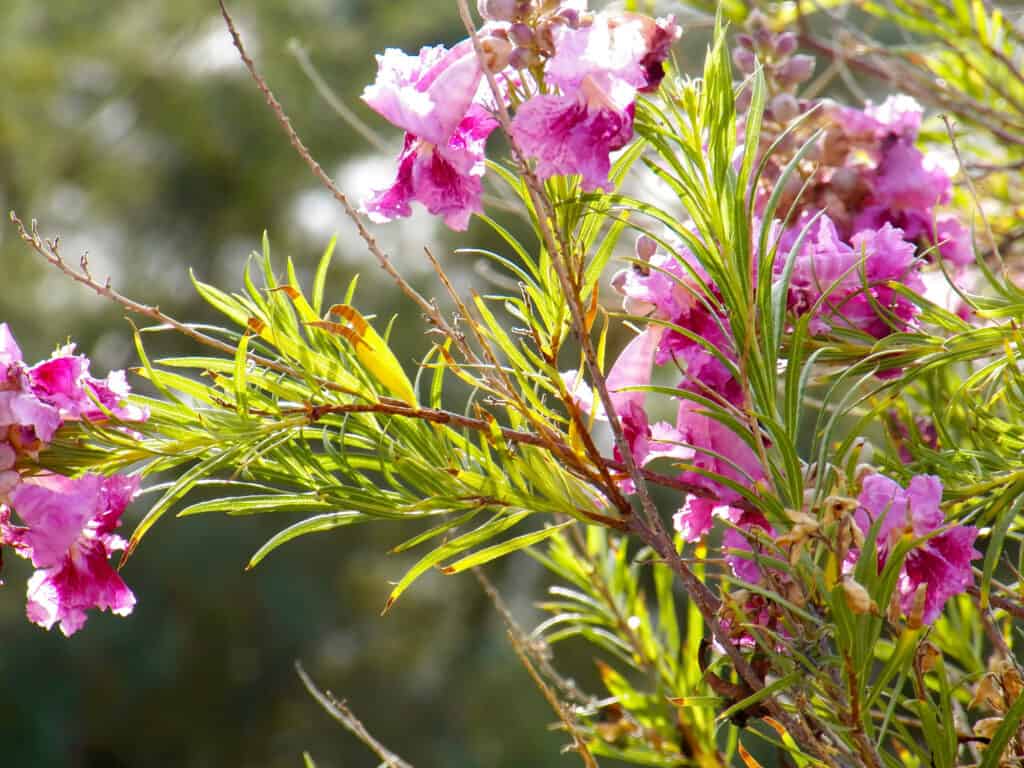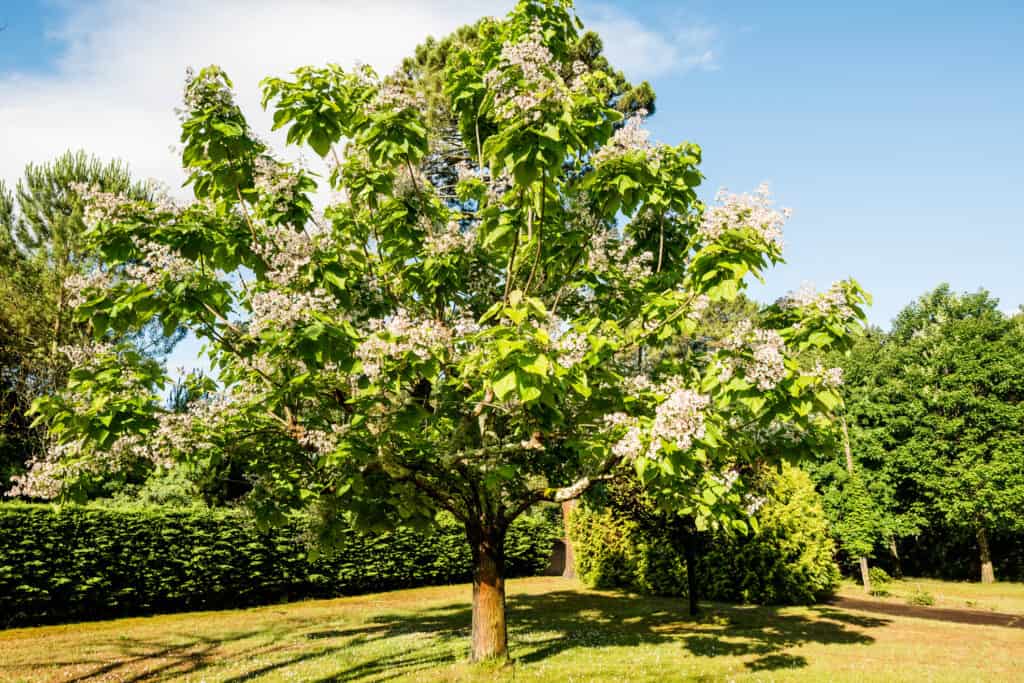What’s the difference between a Chitalpa Tree vs. Desert Willow? It’s a question lots of people ask because they are so similar with their sweetly scented frilly blooms and tolerance of dry soil.
Let’s find out what the difference is.
The Key Differences Between Chitalpa Tree vs. Desert Willow
The main difference is that Desert Willow is a native tree, but Chitalpa is a hybrid created by Desert Willow and the Catalpa trees.
Visually, they can be identified through their leaf shape. Desert Willow has long and thin straight leaves but Chitalpa has lance-shaped leaves that bulge out in the center. They’ll also shorter and more grey-green than Desert Willow’s foliage.
| Chitalpa Tree | Desert Willow | |
|---|---|---|
| Name | X chilopsis | Chilopsis linearis |
| Foliage | Leathery gray-green, lance-shaped and wider in the middle. Up to five inches | Green, leathery and linear up to 12 inches |
| Flowers | Trumpet-shaped frilly white, pink, or white-pink. Cultivars in pink to purple. | Trumpet-shaped white, pink, burgundy, purple depending on cultivar |
| Height and Spread | Fast growing, up to 30 feet x 10 feet | Fast growing up to 25 feet by 10 feet |
| Sun tolerance | Full sun, well-drained soil, tolerates drought | Full sun, well-drained soil, tolerates drought |
| Growing Zones | 6-9 | 5b-9 |
| Toxicity | Not toxic | Not toxic |
What Are Desert Willow Trees?

Desert willows bloom beautiful and aromatic flowers.
©Nikolay Kurzenko/Shutterstock.com
Desert Willow trees are deciduous easy care trees with masses of scented frilly flowers. It thrives in sunshine and copes with drought. It’s a great tree for dry zones.
Its botanical name is Chilopsis linearis and it’s the only species in the Chilopsis genus. It’s not a true willow, but so called because it has long thin willow-like leaves. It’s native to the southwestern United States and Mexico where it grows near sandy streams beneath 5000 feet.
Although it’s a very pretty tree it’s also had practical uses over the years. Native Americans used its wood to make baskets, bows, and its leaves and flowers in medicinal treatments for fungal infections.

The vibrant blooms on the desert willow are trumpet-shaped and come in white, pink and burgundy colors.
©iStock.com/Yolanda P
What Are Chitalpa Trees?
Chitalpa trees are a cross between Desert Willow and Catalpa trees. They have similar trumpet-shaped pink flowers in late spring to summer and deciduous willow-like leaves.
There are two types that were originally bred in modern-day Uzbekistan in 1964 and introduced to America in the 1970s, but since then many more crosses and cultivars have emerged. The two main types are Morning Cloud and Pink Dawn.
And Catalpa Trees?
Chitalpa trees are a hybrid of Desert Willow and Catalpa. There are two species in North America, the southern catalpa bignonioides and the northern catalpa speciosa.
Catalpas are deciduous trees native to warm areas of North America, Eastern Asia, and the Caribbean. They grow to 40-60 feet tall and 40 feet wide with large heart-shaped flowers and pale yellow panicles of showy flowers.
Catalpa is infamous for the catalpa tree worm! These worms are actually sphinx moth caterpillars that only feed on Catalpa leaves. They emerge late June to July and are only active for a few weeks, but they can cause de-foliation. Catalpa trees are capable of regenerating their lost foliage, in fact, fishermen sometimes grow them just for this live bait.

Catalpa trees grow up to 60 feet tall.
©iStock.com/:DEBOVE SOPHIE
Chitalpa Tree vs. Desert Willow Growing Zone
Chitalpa trees can survive temperatures down to 10 degrees farenheit (-12 °C), but they grow best in zones 6 to 9 in full sun with well-drained soil.
Desert Willow is a little tougher. It’s suitable for zones 5b – 9 and needs the same sunny, well drained conditions to thrive.
Chitalpa Tree vs. Desert Willow: Foliage Differences
Both trees have long green willow-like foliage and low canopies, but there are a few differences between them.
Desert Willow has long leaves that grow opposite one another and reach between five to 12 inches in length and up to an inch wide. They are leathery and tough with a scent some people describe as medicinal. In mature branches, the leaves grow in sets of three.
In contrast Chitalpa’s leaves are more green-gray and shorter. They reach a maximum length of five inches by one inch, but also grow in opposite formations in sets of three leaflets.
The main difference between these two trees is their leaf shape. Desert Willow leaves are long and thin, whereas Chitalpa leaves are lance-shaped and fatter in the middle.
How Tall is Chitalpa Tree vs. Desert Willow?
Chitalpa trees can reach heights of 30 feet, but they tend to stay smaller in cultivated gardens. Desert Willow is usually a little shorter. It’ll reach a maximum height of 25 feet. Both spread over 10 feet, so they need to room to grow. Luckily their roots are not invasive and don’t deal damage to structures.
Both species can be grown as small shrubs only a few feet tall with judicious pruning, so they are versatile too.
Are They Fast Growing?
Yes, both of these trees are fast-growing. They can put on two feet a year in good conditions.
Are Desert Willow and Chitalpa Trees Messy?
Both of these beautiful trees are deciduous, which means they drop their leaves in fall. Along with their leaves, they also drop their long seed pods and fluffy seeds. So they are a little messy, but there’s no staining fruit to deal with.
How To Look After Chitalpa Tree vs. Desert Willow
Both Desert Willows and Chitalpas are very easy to grow and thrive on neglect. They’re great trees if you’re busy or forget to water your plants. Happily for us, they grow in the same conditions.
Choose a spot in full sun, because they struggle to flower in shade. The best soil is well drained, but newly planted trees will need regular water until you spot new growth. These gorgeous trees tend to prefer slightly acidic soil, but they grow in the majority of spots so long as it’s not waterlogged. Don’t be tempted to fertilize them. This only promotes brittle new growth that easily snaps.
Because they are trees native to hot, dry regions, you can improve their chance of flowering by introducing gravel and stone to rebound heat.
Do You Prune Desert Willow?
You can leave Desert Willow and Chitalpas to their own devices and wildlife will appreciate the undisturbed crown. If you’re after a more ornamental look, trim off crossed branches and prune it back to create a pleasing shape.
Do Chitalpa Trees Have Flowers?
Yes, they certainly do and the flowers are orchid-style glorious.
Depending on the species, Chitalpa blooms are white, pink, pale yellow or purple, but they’re all large (up to several inches in length and an inch across) and resemble dangling frilly trumpets. They have a sweet exotic scent and bloom from May to October or longer in the hottest zones.
Desert Willow blooms are almost identical. Wild specimens are white and pink, but there are cultivars ranging from purple to burgundy too.
It’s not just humans that love Desert Willow and Chitalpa flowers, hummingbirds love them too. Experts think they are attracted to the bright pink color of their petals and their yellow throats that show hummingbirds exactly where to feed. Other pollinators like bees and butterflies love them too, but hummingbirds are able to reach further inside their trumpet shape.
Are Chitalpa or Desert Willows Toxic To Dogs?
The ASPCA doesn’t list Chitalpa or Desert Willow as toxic to dogs, cats, or horses, but their leaves and flowers are similar to Oleander which is toxic. It’s best to double-check your trees!
Which One Do I Have?
The easiest way to determine whether you have a Desert Willow or a Chitalpa is by looking at the foliage. Desert Willow has long leaves that are linear and run the same length along the whole leaf. Chitalpa leaves are fatter in the middle.
Should I Choose Chitalpa or Desert Willow?
There really isn’t much to choose between these two sweetly scented flowering trees. They grow in the same conditions and both produce hummingbird-friendly frilly blooms. The biggest difference is their foliage shape. Desert Willow has linear green foliage up to 12 inches long whereas Chitalpa has gray-green lance-shaped foliage up to five inches long.
It’s also worth remembering that Desert Willow is slightly hardier spanning zones 5b to 9 whereas Chitalpa is best grown from zone 6.
Up Next:
- 17 Gorgeous Flowering Trees in Texas
- Discover 10 Resilient Plants That Can Thrive in a Desert
- Why Do Leaves Change Color in the Fall?
The photo featured at the top of this post is © iStock.com/Yolanda P
Sources
- American Society for Horticultural Science, Available here: https://journals.ashs.org/hortsci/view/journals/hortsci/41/5/article-p1162.xml
- The University of Arizona Cooperative Extension, Available here: https://ag.arizona.edu/maricopa/garden/html/pubs/0104/willow.html
- New Mexico State University, Available here: http://medplant.nmsu.edu/chilopsis.htm
Thank you for reading! Have some feedback for us? Contact the AZ Animals editorial team.






